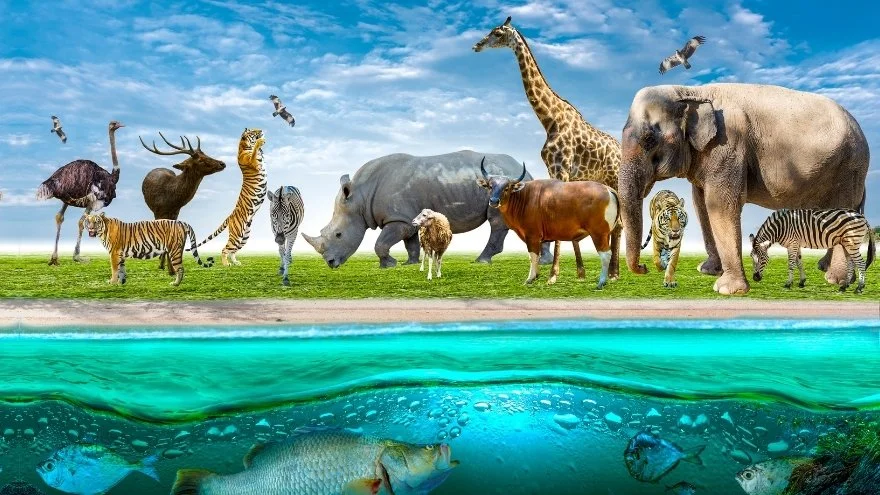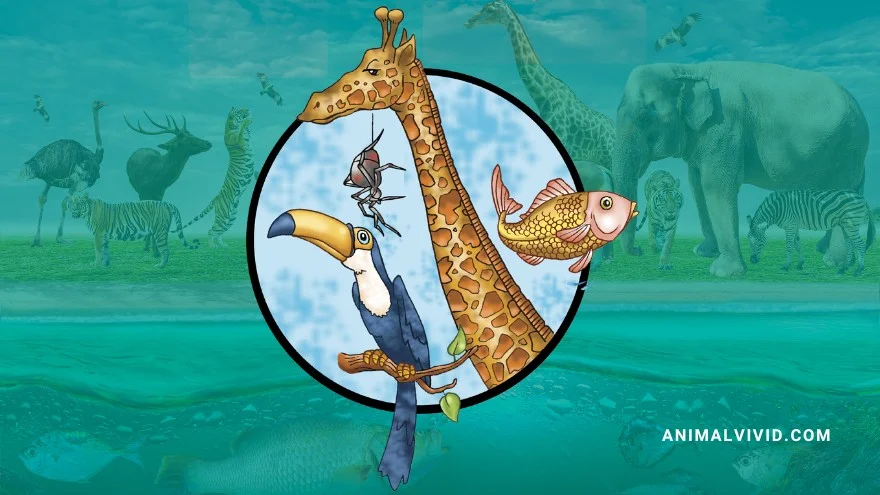Animals have different characteristics that call for classification into multiple categories. This animal kingdom classification is important—not just to learn about the different species, but the relationship shared by all.
The system was created by a Swedish botanist named Carl Linneaus. It was termed the Linnaeus method or the Linnean method, and it is essentially used to group animals in a hierarchy known as taxa.
This method also serves to give species binomial names by fusing the genus and species. This is often known as the binomial nomenclature.
The primary method of classifying animals includes domain, kingdom, phylum, class, order, suborder, animal families, genus, and species.
Animal Kingdom Classification – Animalia

Domains
The domain is often called the least specific category of classification, and it regroups all of life. There are three main domains:
- Bacteria: for cells that don’t contain a nucleus
- Archaea: for cells that don’t contain a nucleus and have a cell wall that’s different from bacteria.
- Eukarya: for cells that contain a nucleus.
The bacteria and archaea domains are quite similar in that they have no nucleus and are both composed of organisms that have only one cell. The organisms also reproduce asexually by dividing into two.
The domains are distinguished by the material that makes up their cell walls.
The bacterial cell wall is made up of polysaccharide peptidoglycan which the archea doesn’t have.
The latter also thrives in a more extreme environment in which bacteria can’t survive in.
The eukarya is a domain of its own, and all living organisms here have a nucleus where the genetic material is stored. This genetic material is also called DNA.
Four kingdoms are classified under the eukarya domain (animal, plant, fungus, protist) while the other two fall under the bacteria and archaea.
Kingdoms

There are in total six different kingdoms in which all living organisms can be classified. Here they are in more detail:
Animalia
This kingdom is composed of eukaryotic, multicellular, organisms. They are termed heterotrophic because they can’t produce their food but would rather depend on other plant and meat sources to get nutrition.
These organisms also move. Every animal, living and extinct, belongs to this category. Examples are wolves, cats, and elephants.
Plantae
Rather than being heterotrophic, plants are autotrophic. This means they produce their food through a process known as photosynthesis. Plants are usually not motile.
You would find them in one spot. Examples include grass, flowers, and different tree types.
Fungi
Like the Animalia kingdom, fungi (singular: fungus) are multicellular organisms that do not produce their food.
They are very different from plants, and also distinguish themselves from animals by what they eat.
They feed more on organic matter. Examples include yeast, mushrooms, and molds.
Protista
The protist is a single-celled organism that could be likened to bacteria and archaea, except that protists are more complex.
They fall under the eucaryotic domain. Some protists produce food on their own by photosynthesis, others don’t.
They are usually motile due to flagella, cilia, or pseudopods. Examples include amoeba and algae.
Eubacteria
The eubacterium is a kingdom under the bacteria domain, and they are characterized by a lack of a nucleus.
These organisms play a huge role in the ecosystem, and while some may be harmful to humans, they are not all in that category.1
We even have some bacteria in our intestines, and they help in the making of yogurts. This kingdom covers all bacteria that aren’t archea.2
Archaebacteria
Archea is similar to bacteria in that they have no nucleus. They are considered the oldest known living organism and can survive in hot areas not considered suitable for bacteria.
Phylums
The next classification after the kingdom is phylum. There are 7 different phyla under which animal species are categorized. They include:
Porifera
The Porifera is the phylum of marine animals that consists of sponges—as these animals are called.
Their bodies are filled with pores and they are multicellular. These sponges can be found in every ocean.
Cnidaria
This phylum also consists of marine mammals, but not the spongey kind. It regroups over 11,000 species of aquatic animals.
The phylum is further classified into some groups: Anthozoa, Scyphozoa, Hydrozoa, Cubazoa, etc. Examples of cnidarians are corals, jellyfish, and anemones.
Mollusca
The Mollusca is the largest aquatic phylum and the second largest by species count.
There is an estimate of 85,000 extant species in this phylum, and there may be much more still unrecognized. Common examples are clams, snails, and mussels.
Arthropoda
The Arthropod phylum is the largest by species count, and it comprises invertebrates. The subgroups under the phylum include insects, crustaceans, and arachnids.
Arthropods are characterized by exoskeletons and bodies divided into segments. Common examples are scorpions, shrimp, and butterflies.
Chordata
Chordata is predominantly vertebrates, which means the species under this phylum have backbones.
Besides this, they also have some other unifying traits like a circulatory system and a celom. Examples of Chordata are dogs, cats, and horses.
Annelida
The Annelida consists of over 22,000 species, and it is a large phylum. It can also be called the ringed worm or segmented worm.
The species under this phylum have a nervous system, sense organs, and a respiratory system. Examples are the earthworm and leeches.
Platyhelminthes
The Platyhelminthes are also worms, but they are less complex than the annelids.
They don’t have any respiratory or circulatory systems but breathe through a process known as diffusion. Examples are earthworms and leeches.
Classes
Classes come after the phylum, and they are more specific than the three first categories we’ve mentioned so far. We’ll narrow it down to the Chordata phylum, where there are seven classes:
Agnatha
This class is composed of jawless fish, all of which are vertebrates. The name originated from an Ancient Greek word that translates as “without jaws”. An example is the European river lamprey.
Chrondichtyes
The Chondrichthyes are opposed to the agnatha class in that the members have jaws.
They also have cartilages in place of bones, paired fins, paired nares, scales, and a heart. Examples of Chondrichthyes are the sleeper ray and the whale shark.
Osteichthyes
The Osteichthyes have bones rather than cartilage, making them a direct contrast to the Chondrichthyes. This class contains most fish at sea. It consists of 45 orders, over 430 families, and 28,000 species.
It is considered the largest class of vertebrates, and there are two groups underneath the class: the ray-finned fish and the lobe-finned fish. Examples are the Queensland lungfish and the Iridescent shark.
Aves
Aves is a class of birds, warm-blooded vertebrates with pairs of wings and skin made of feathers.
They also have beaks (no teeth), a strong skeletal system, and the ability to lay eggs. Most of them can fly with wings, but this isn’t an absolute rule.
Fun fact: Birds are considered dinosaurs and are the only surviving ones! Examples of aves are penguins, ratites, and peacocks.3
Reptilia
Reptiles are characterized by scaly skins, and they could either have limbs or crawl on their stomach. They are all vertebrates and have close ties with birds.4
There are more than 11,000 species, many of which can be dangerous to humans. Examples of reptiles still existing today are lizards, snakes, crocodiles, and turtles.
Amphibia
Amphibians are described as tetrapods and ectothermic, which simply means they move on four limbs and rely on the environment to generate heat.
They are usually classified under a group of tetrapods known as Lissamphibia. Examples are frogs, salamanders, and toads.
Mammalia
Mammals are characterized majorly by the presence of the mammary gland in females.
The name is acting derived from the Latin mamma which means breast. They also have fur or hair, a well-developed brain, and three middle ear bones.
Order
The classes can be further broken down into orders, which is even more specific. It is often difficult to know how many orders should be in a class.
In the Mammalia class, for example, some count up to 26 orders, others say 17, and a third category even gets to 29.
Here are some of the popular orders in the Mammalia class:
Carnivora
The Carnivora order eats mainly meat, just as the name implies. However, some of them are omnivores and even herbivores. Examples are bears, dogs, and cats.
Rodentia
Rodents are usually small mammals that are characterized by long tails, a single pair of incisors on the upper and lower jaw, and skin made of fur. They make up about 40% of the world’s population. Examples are rats and rabbits.
Chiroptera
The Chiroptera holds the record of being the only mammal that has wings and can fly. They tend to fly better than other birds. The only example of the Chiroptera is the different bat species.
Primates
This is a diverse order, divided into three groups. We have the strepsirrhines, the haplorhines, and the simians.
They are characterized by large brains, color vision, and a big reliance on sight. Examples are lemurs, monkeys, and apes.
Cetacea
The cetacean order consists of aquatic mammals, and their biggest trait is the ability to survive underwater.
They have a body shape that enables them to adapt to the underwater and a high level of intelligence. Examples are the different whale species we have.
Artiodactyla
Also called even-toed ungulates, these animals bear weight equally on two of their five toes—hence the name.
They can be contrasted to another mammal order named Perissodactyla which are odd-toed ungulates.
Examples of both orders are the Indian rhinoceros, the Brazilian tapir, the American bison, and the giraffe.
Families
There are many families in each order. In the mammalian class, there are up to 125 families. Here are some of them according to the orders under which they are classified:
Carnivora
- Felidae (cats)
- Canidae (dogs)
- Ursidae (bears)
- Mustelidae (weasels)
Primates
- Lemuridae (Lemurs)
- Cebidae (New World Monkeys)
- Tarsiidae (Tarsiers)
- Pongidae (Apes)
- Hylobatidae (Gibbons)
Rodents
- Anomaluridae
- Pedetidae
- Castoridae
- Geomyidae
Genus
The genus is comprised of animals that are very closely related. It divides a family into even smaller groups. Some genera we have are:
Felidae family (cat)
- Felis (domestic cats)
- Puma (panthers and jaguars)
- Panthera (Tigers, leopards, jaguars)
Canidae family (dog)
- Canis (Coyotes, jackals)
- Atelocynus (short-eared dog)
- Cerdocyon (crab-eating fox)
Species
Every individual animal you see falls under a particular species which is tied to a genus. The binomial name given to these individuals is often a merging of the genus and the species. Some examples are:
- Red fox (Vulpes vulpes)
- Brown recluse (Loxosceles reclusa)
- Grizzly bear (Ursus arctos horribilis)
Examples of Animal Classification
Case 1: Red Fox
- Kingdom: Animalia
- Phylum: Chordata
- Class: Mammalia
- Order: Carnivora
- Family: Canidae
- Genus: Vulpes
- Species: Vulpes vulpes
Case 2: Corn Snake
- Kingdom: Animalia
- Phylum: Chordata
- Class: Reptilia
- Order: Squamata
- Family: Colubridae
- Genus: Pantheropis
- Species: Pantheropis guttatus
Case 3: Common Ostrich
- Kingdom: Animalia
- Phylum: Chordata
- Class: Aves
- Order: Struthioniformes
- Family: Struthionidae
- Genus: Struthio
- Species: Struthio Camelus
Conclusion
Animals are classified based on a set hierarchy and each species has a binomial name. This is according to the Linneaus method which was used in this article.
The classification goes from the broad domain to the more specific species, and in the middle of all that, we see the kingdom, phylum, class, order, family, and genus.
These classifications are done to draw out the relationships that exist amongst animals, as well as to keep track of the extant species.
References & Notes
- Life History and Ecology of Bacteria. University of California, Berkeley.
- Your Gut Bacteria and Your Health. WebMD Editorial Contributors.
- Hendry L. Why are birds the only surviving dinosaurs? Natural History Museum
- Nikolas. If birds evolved from dinosaurs, would that make them reptiles too? Arizona State University.






